Yesterday we woke to the drumming sound of rain on the roof. From that point on the morning was a complete disaster! While Ian went off in the rain to the shower, Jill organised breakfast, before her turn at showering. Popping outside for fresh water, Modestine’s back door closed with the wind and locked itself. This is a complete impossibility as she is designed in such a way that it cannot happen. But it did! Jill, alluringly attired in nightie and flip-flop sandals, struggled in vain with the door handle as it began to dawn on her that we were in a bit of a pickle! Not only was it wet, it was freezing cold and there was nobody on duty at the site! Our keys were all dangling from the hook inside and the fire was busy churning out lots of hot air, but we were stuck outside! Ian was not best pleased when he squelched his way back across the field from a nice warm shower. Jill wrapped herself in Ian’s damp towel for warmth and we searched for help, in the end hammering on the door of the only other English vehicle on the site and asking for shelter until someone arrived at the site office. The camper van was owned by a retired Englishman from Scarborough travelling alone. We were very impressed by him. Having ordered his big, state of the art, campervan last year to travel with his wife, she died leaving him to take delivery of their vehicle alone. He decided he had to get on with his life so had been travelling around Spain and Portugal for a couple of months without speaking a work of the language! We cannot imagine how sad it must be to undertake such an adventure with nobody to share it with, nobody to argue with, nobody to navigate, nobody to come up with a bright/stupid idea for solving a problem. And all the time coming to terms with the loss of one’s partner and thinking every day how much she would have enjoyed/hated doing this.
Anyway, this kind man took us in and gave us mugs of hot tea, sheltering us from the freezing rain for an hour and lending us his keys to try in our lock. When staff eventually arrived at the office we had to explain in Spanish what had happened and ask if someone could find the nearest Citroën dealer with a universal key. The nearest dealer and the nearest locksmith were both at Gijon, and neither where willing to drive to Candas on a Saturday morning to help us! By now we were frozen through, our bare feet had lost all sense of feeling, our money and Jill’s bra were both inside Modestine leaving us without any means of support – visible or invisible! Realising Jill was a bit chilly wearing little but a rain drenched towel, la señora placed her by a hot radiator and turned on the Saturday morning cartoons, before she called a friend. We dread to think how he normally earns his living, but while Jill thawed out and improved her Spanish with the cartoons, poor Ian, only slightly better attired, acted as gemmy operator’s mate while Modestine’s back door was forced open!
Fortunately not too much damage has been done but we will need to replace the window lock as soon as possible and the door lock is obviously faulty so needs investigating. Ian is now wearing our spare key permanently round his neck!
Imagine our joy at getting back inside our tiny capsule of warmth that has contained our whole world for the past few months! Everything felt very different once we had warmed up and dried out. How wonderfully kind everyone had been. We were well impressed that we’d coped entirely in Spanish so we must have learnt something during the last few months! It was only later we discovered by chance, that although nobody spoke English, la señora actually spoke French so we could have saved ourselves lots of trouble!
Although our plans had been knocked sideways, as the rain had stopped we decided to take the narrow-gauge railway into Gijon for the afternoon. This proved an enjoyable 20 minute ride along the seashore, along a tightly winding track through several long tunnels. The little rural stations were all covered in rather unsightly graffiti, though the communist propaganda at Candas was very neatly done. There has been a long tradition of militant socialism in Asturias, perhaps because it is in a region with heavily industrialised areas. The miners were suppressed with a firm hand when they rose up in the 1930s but the communist tradition seems to live on.
 FEVE narrow gauge railway and communist slogans, Candas, Asturias
FEVE narrow gauge railway and communist slogans, Candas, AsturiasGijon has a population of around 200,000 with a harbour and an old castle on a headland. It isn’t an outstanding town but seemed pleasant enough with many art nouveau houses. There must be a fiesta of some sort happening this weekend as the streets were crowded with children in fancy dress – lions, fairies, zebras, skeletons, knights, devils and witches. It’s obviously a passion here to dress up and there are lots of shops devoted entirely to selling fancy-dress costumes. On the way home on the train we were invaded by Darth Vader, a whole team of riot police and a fairy with gold hair. Outside the 18th century Palacio Reveillagigedo in Gijon, the impressive statue of Pelayo - first king of Asturias who defeated the Moors at Covadonga around 722 - was also taking part in the carnival, his crowned head disguised as a bright yellow chicken with a red beak!
 View across the marina, Gijon, Asturias
View across the marina, Gijon, Asturias Pelayo disguised, Gijon, Asturias
Pelayo disguised, Gijon, AsturiasBack in Candas around 6.30pm we found similar excitement as families joined in the evening paseo, their children dressed in fancy costume and little groups of majorettes giggling together on street corners in the dark. It was cold and nothing much seemed to be happening so we went to the local museum, the Museo Anton. In common with most museums and art galleries this is closed during the afternoon but open until 7.30pm in the evening.
This turned out to be a delight and dedicated to the works of one local man, Antonio Rodríguez García, who painted under the name of Anton. He died in 1937 during the Spanish Civil War at the age of 26. The work he produced, mainly in cast bronze, was stunning. He really seemed to have captured the spirit of the persons he depicted. It was astonishing that such a high degree of technical skill and emotional expression could have been achieved by such a young artist. We were highly impressed to discover such impressive work in a little Spanish town and felt that his work deserves wider recognition.
 Museo Anton, Candas, Asturias
Museo Anton, Candas, Asturias Bronze in Museo Anton, Candas, Asturias
Bronze in Museo Anton, Candas, AsturiasThroughout the town there are many examples of local art displayed in ceramic tiles or mural paintings as a permanent outdoor gallery.
 Panorama, Candas, Asturias
Panorama, Candas, AsturiasBy the time we rejoined Modestine, contrite after her earlier bad behaviour, we were very weary after a day that seemed full of very different incidents. We slept deeply, only vaguely aware that the bad weather had returned during the night.
This morning, Sunday, we woke to a grey, drenched world. The waves of the sea tumbling on the beach just below us were the same shade of grey as the dark skies that have teamed down rain upon us all day. With such weather there was no point in staying longer so we abandoned our plans to take the train to Oviedo and continued westward along the coast towards the Picos de Europa, hoping for an improvement.
We visited the Picos some fifteen years ago and found it a wonderful area. We have always wanted to return and throughout our travels around the Iberian Peninsula we have looked forward with keen anticipation to spending a few days there. However, we had reckoned without the weather. We have now left the warm south far behind and have returned to the snows of mountains. Following the near deserted coast road, through long road tunnels, several more than a kilometre long, beneath the mountains, we were pounded by ceaseless rain, the roads awash with water. We turned inland up towards Cangas de Onis, hoping to find a pension as there are no campsites open anywhere here. Rain turned to sleet and then to driving snow as we climbed into the mountains. Seeing a vehicle by the roadside fitting snow chains we decided it was too risky to go higher into the invisible mountains, blotted out by mist and driving snow. So we turned into the Parador at Candas, at the Monastery of San Pedro de Villanueva, founded in 746 but mainly Romanesque. Here we indulged in the luxury these places afford, with coffee and cheesecake in the cloisters – centrally heated and closed in by glass, surrounded by all the attendant luxury we had come to expect of these state-run enterprises.
 Monastery/Parador of San Pedro de Villanueva, Cangas de Onis, Asturias
Monastery/Parador of San Pedro de Villanueva, Cangas de Onis, Asturias 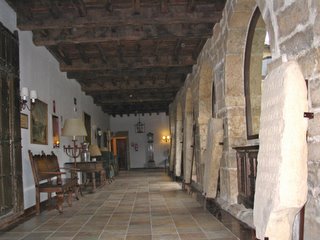 Monastery/Parador of San Pedro de Villanueva, Cangas de Onis, Asturias
Monastery/Parador of San Pedro de Villanueva, Cangas de Onis, Asturias Monastery/Parador of San Pedro de Villanueva, Cangas de Onis, Asturias
Monastery/Parador of San Pedro de Villanueva, Cangas de Onis, Asturias A young English couple chatted with us, finding it funny that we were librarians as, travelling around Europe in a camping car, we do not fit the stereotype image – apparently there has been negative press coverage in Britain recently about librarians being boring people. They are bilingual and over here to sign a contract with their Spanish solicitor enabling them to purchase some land locally so they can build luxury properties for Brits wanting to explore the Picos de Europa. This is a really beautiful area and we’d come back again and again, but it takes courage to invest here rather than in the hot, arid but popular south! They met each other on the Inca trail in South America and have assured us we are not yet past doing it. Ian has always longed to see Macchu Pichu, so who knows where next year’s travels will take us! We have met a lot of interesting people during our travels all with a wide range of experiences.
Last time we were here we stayed in the little mountain town of Arenas de Cabrales and hoped to stay at the same place this time, but the roads were really icy as we left the Parador. Commonsense prevailing we reluctantly retraced our route down to the sea, where it is several degrees warmer, the snow turning to rain as we left the Picos behind. We stopped for lunch in Modstine along the coast with wonderful views of the sea pounding the rocks.
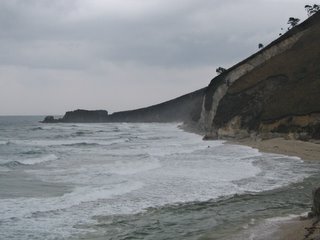 Playa de San Antolin, Asturias
Playa de San Antolin, AsturiasOur route continued through Ribadesella and Llanes until we arrived at St. Vicente de la Barquera. Here, around 5.30pm the rain finally ceased. We visited this picturesque little port on our previous visit to the area and were happy to re-explore its delights. We have found a little hotel that is clean and pleasant for a mere 24 euros – after Modestine it is huge! As Spanish camp sites have been charging between 18 and 23 euros, this seems excellent value with our own bathroom, endless hot water and room to swing a cat each if we so wish!
We climbed up to the castle, the Castillo del Rey, open until 7pm, with spectacular views from its tower over the town, the two river estuaries or rias, and the open sea. According to pictures there are snowy mountains looming up behind but if they were there, they were completely hidden by the thick grey mist. The town was constructed here in an excellent defensive position, on the ridge at a point where the two rias meet.
 San Vicente de la Barquera, Cantabria
San Vicente de la Barquera, Cantabria Castillo del Rey with Nuestra Señora de los Angeles, San Vicente de la Barquera, Cantabria
Castillo del Rey with Nuestra Señora de los Angeles, San Vicente de la Barquera, Cantabria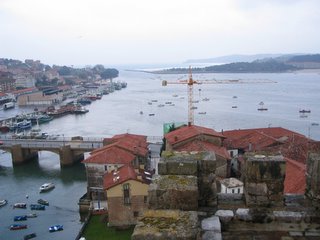 View out to sea from the Castillo, San Vicente de la Barquera, Cantabria
View out to sea from the Castillo, San Vicente de la Barquera, Cantabria Wetlands in the ria, seen from the Castillo, San Vicente de la Barquera, Cantabria
Wetlands in the ria, seen from the Castillo, San Vicente de la Barquera, CantabriaThe Picos, like the Jura, are limestone and are riddled with caves, many having been inhabited in prehistoric times, their walls bearing evidence of early paintings. The Altamira caves are at Santillana, slightly further up the coast from here. The castle has an excellent exhibition on speleology and local geology. Much of its walls and its ancient tower remain while beyond stands the medieval church Nuestra Señora de los Angeles.
With a couple of days of pictures and events to process, and the novelty of lots of space, rather than wander the cold dark streets searching for Asturian fabada, we returned to the luxury of our hotel room and spent the evening drinking wine, eating spicy sausages and nutty chocolate and using some of the endless supply of hot water to wash our accumulation of dirty laundry.
Monday 27th February 2006, San Vicente de la Barquera
We are enjoying warmth, space, hot water, Spanish television and four soft white bath towels so much we have decided to stay another night at this tiny pension with only four guest rooms. Another novelty is twin beds. This is the norm in Spain and we have now learnt that we need to request a matrimonial bed if we want anything else! Having been squashed together in Modestine for weeks now we are both rather enjoying flailing around without waking each other up!
This morning the streets were dry and before long the sun even put in a rather watery appearance. Just around the corner, near the fishing harbour, we found a little café where we ordered a couple of desayunos – coffees with toasted croissants served with butter and jam. Very nice is a sweet, sticky sort of way, but oozing with cholesterol. (Not good for pensioners!)
The lure of the Picos got to us. For fifteen years we have longed so much to visit these mountains again. There was no guarantee that we would see anything or that the roads would be passable but we headed up to the picturesque little town of Potes through the deep Desfiladero de la Hermida. This is a deep, narrow ravine cut by the river Diva. It is so deep and narrow that sunlight cannot penetrate to the bottom and its sides are bare of vegetation. As the road twists its way through, occasional glimpses can be caught of snowy mountain peaks high above, though mostly all we could see were swirling wisps of clammy dank clouds. About half way we stopped at Nuestra Señora de Lebeña, a tiny tenth century, Mozarabic (pre-Romanesque) church. It was closed today but even the outside was worthy of a detour set as it is amidst cypress trees and a flowering cherry, the mountain peaks towering above.
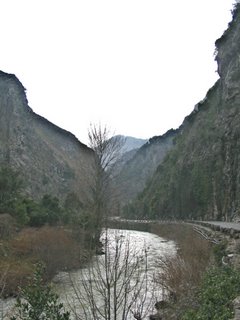 Desfiladero de la Hermida, Asturias
Desfiladero de la Hermida, Asturias  Nuestra Señora de Lebeña, Asturias
Nuestra Señora de Lebeña, Asturias It was market day in Potes and crowded with people buying wooden pronged forks for turning freshly scythed grass, and nylon aprons for village ladies pushing wheelbarrows. This is really true! We have seen many ladies in flowery aprons and wellies in isolated areas of the countryside pushing wheelbarrows along the roadside! Both on this visit, and our last, we saw more wheelbarrows in active use here than we have seen altogether in the rest of Europe! The other characteristics of the area, apart from the countless horreos, are the sleeping dogs in the road and the innumerable elderly little men whom we pass along the roadside, miles from habitation, toddling along with a walking stick and black beret. We have taken to calling them national treasures and assume that like the Parador hotels, they are a state-run institution. They must be deposited in the countryside each morning and collected at night as they are always walking from nowhere to nowhere! Occasionally we see slightly younger ones and have concluded that they are on a youth training scheme!
Potes is shut in by mountains and today their white peaks could be seen, swathed in clouds. We explored the steep cobbled back streets and rediscovered the little hotel we used on our previous visit. There was little else we could recall however and searched in vain for the place we first encountered the delicious thick bean and sausage soup known locally as fabada.
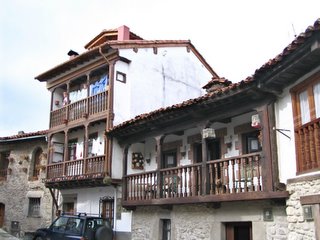 Typical scene with washing drying, Potes, Asturias
Typical scene with washing drying, Potes, Asturias 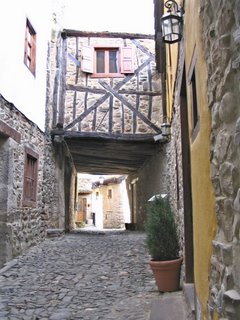 Street in Potes, Asturias
Street in Potes, Asturias  Riverside houses in Potes, Asturias
Riverside houses in Potes, Asturias Not being great amateurs of the countless seafood dishes down at the coast, we decided to profit from being in the mountains by trying a local speciality, Plato Liebaniego, but with little idea of what it would be. It turned out to be straight out of the Atkins diet book! Picadillo, morcilla, borono, huevos, lomo and fritos (chopped fried bacon, black pudding, sausages, fried eggs, pork chops and chips!)
 Just what the Dr. (Atkins) ordered! Potes, Asturias
Just what the Dr. (Atkins) ordered! Potes, Asturias Wishing we had translated the menu before ordering we staggered back to Modestine and drove up to a mountain monastery a little further on - San Toribio des Liebana, it was founded by the Benedictines in the 7th century. The largest known fragment of the true cross of Christ was brought there in the 8th century from Jerusalem. This is displayed in the chapel and is supposed to show the actual nail hole where Christ’s left hand was fixed to the cross. Here in the 8th century Beatus compiled illustrated commentaries on the Apocalypse of St. John and facsimilies of these strange and beautiful illuminations are displayed around the cloisters.
 San Toribio des Liebana, Asturias
San Toribio des Liebana, Asturias On a promontory above the monastery stands the hermitage of San. Miguel. From here we had vistas through the clouds to the snow covered jagged mountain tops across the valley and the tiny town of Potes nestling far below. As we were leaving this tranquil spot one of the monks in his sandals and thick woollen robes strode along the road towards us, presumably on his way to pray at the hermitage. He raised his hand to bless us as he passed but we thought he was just being friendly so waved back!
 Potes seen from the hermitage of San Miguel, Asturias
Potes seen from the hermitage of San Miguel, Asturias 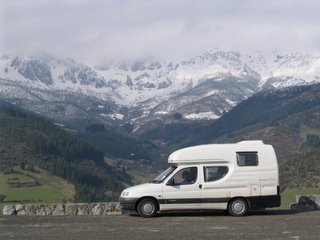 Modestine goes to the mountains, Asturias
Modestine goes to the mountains, Asturias We had spent too long in Potes really but were not to know that the sun would burst out and the clouds lift. We were desperate to climb higher into the mountains but the round route was nearly 200 kilometres of twisting mountain roads. However, we reckoned we could just do it before dark. During the whole trip we saw only a few 4x4s and some snow ploughs! As we climbed, the snow lay piled up beside the road where it had been pushed earlier in the day by the plough, and the landscape became increasingly rugged and savage. Eventually we were way above the tree line with nothing but snow and mountain peaks until we reached the top of the Puerto de San Glorio at 1609 metres. The far side was within the province of Leon rather than Asturias, and being on the northern slopes their snow ploughs had a bigger road clearing job to deal with! Our descent was strewn with ice and we passed several teams of vehicles still busy clearing way the blockages caused by yesterday’s snows.
 Climbing into the mountains, Asturias
Climbing into the mountains, Asturias  Up into the snows, Asturias
Up into the snows, Asturias  Picos de Europa, Asturias
Picos de Europa, Asturias  Through the windscreen, Picos de Europa, Asturias
Through the windscreen, Picos de Europa, Asturias  Modestine takes a rest, Picos de Europa, Asturias
Modestine takes a rest, Picos de Europa, Asturias  Mountain village, Picos de Europa, Leon
Mountain village, Picos de Europa, LeonEventually we reached the mountain reservoir known as the Embalse de Riaño, This was quite spectacular, the edges being a sheet of ice, while further out the black water reflected the peaks of the surrounding mountains. Such scenery as this was worth driving right round Spain and Portugal to reach! We are already planning when we can come back again!
 Embalse de Riaño, Picos de Europa, Leon
Embalse de Riaño, Picos de Europa, Leon Embalse de Riaño, Picos de Europa, Leon
Embalse de Riaño, Picos de Europa, LeonFor a further sixty kilometres we wound our way down through the snows to Cangas de Onis, the first Christian capital of Asturias after the Moorish conquest. Yesterday we had tried in vain to climb up from here. We would never have managed it but today, thanks to the snow ploughs, we were now able to get through and the recent snow had made it even more spectacular.
 View from the side window, Picos de Europa, Leon
View from the side window, Picos de Europa, Leon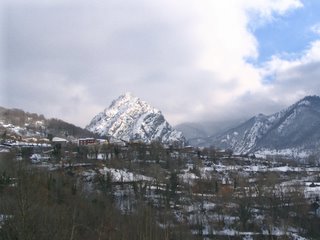 Mountain village of Oseja, Picos de Europa, Leon
Mountain village of Oseja, Picos de Europa, Leon The route we had to abandon yesterday was passable today, Picos de Europa, Asturias
The route we had to abandon yesterday was passable today, Picos de Europa, Asturias Mountain goats below the snow line, Picos de Europa, Asturias
Mountain goats below the snow line, Picos de Europa, AsturiasWe returned to San Vicente along the mountain route through Arenas de Cabrales. By now it was dusk so we were unable to stop but we recognised the hotel we’d used fifteen years ago. The little town is an excellent centre for exploring the area and we will definitely come back here again one day. For us it is the most stunning of Spain’s landscapes.
 Naranjo de Bulnes from near Arena de Cabrales, Picos de Europa, Asturias
Naranjo de Bulnes from near Arena de Cabrales, Picos de Europa, Asturias